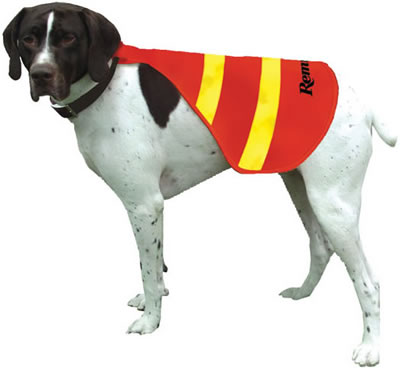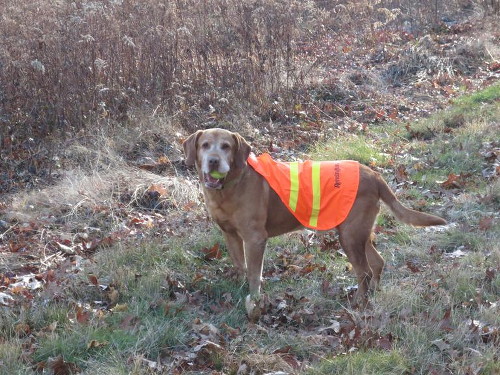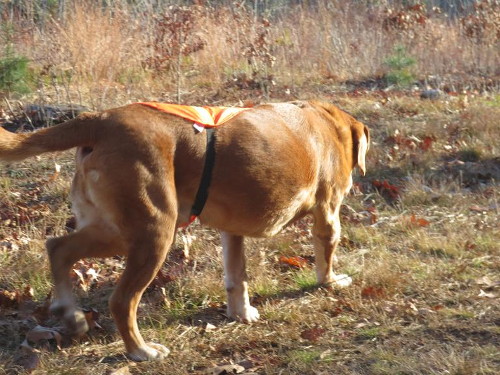The Remington Safety Dog Vest
Ted Ruegsegger
29 November 2013
The Engineer's Lot
Engineers see the world around them in ways that others don't. This makes life interesting and satisfying but punctuated with moments of jaw-clenching frustration whenever we perceive a thing that could have been done right, but wasn't. This is one of those moments.
The Problem
It's deer season again and everyone (including the hunting community) agrees that we'd all be better off if we wore orange outdoors. It seems that some subset of the hunting community can't be relied on to make absolutely sure of the target before firing off a deadly projectile or two, but if the object in their sights has some orange on it they'll realize it's not game their license allows and hold their fire.
We recently adopted a dog who is entirely deer-colored, so we're more concerned than in past years with reflective orange coverings. It was hard to adapt a human safety vest to his body, so we shopped around for orange safety vests for dogs. Should be easy, since hunting season was just beginning. Nope, only one local store (Dave's Pet Food) carried one, a couple of sizes too small, buried behind a huge display of brightly-colored dog toys (we all know that dogs don't really see color, right?)
What Should Have Been the Solution
After some googling and perusing various websites, we found "Remington Orange Reflective Safety Dog Vests, Large" from CountryMax.com. This looked and sounded like exactly what we needed, so we ordered a couple.
The Ad is Deceptive
Many dog vests seem to be focused primarily on the top of the dog's body, as if the greatest danger came from hunters in helicopters or perhaps low-orbit ion cannons. What I liked about this vest is the complete coverage of the dog's flanks, as shown in the picture:

Turns out, it's not really so. While the picture suggests that the side lobes extend all the way down, in fact they stop well short, at which point a skinny black strap wraps around the dog's belly and attaches with Velcro. The photo is likely of a medium-size dog wearing a large-size vest.
It Gets Worse
The ad says "The vest features a loop at the top that attaches securely to your pet's collar for added safety." Not only that, but the loop has a buttonhole-like slot for attaching the leash to the collar. Here's where I began to suspect the designers had seen dogs but didn't actually own any, perhaps stretching their prototypes over dog-shaped mannequins.
Pretty much every dog collar commonly available has exactly one steel ring. To this ring are attached:
- a dog license
- a rabies tag
- a microchip data tag
- an easily-readable tag with the dog's name and the owner's contact information
All these tags are attached with relatively flimsy fasteners, with a split ring or an S-shaped hook. By flimsy, I mean when the leash gets attached to the same ring and the dog jolts it in every direction, eventually tags go missing.
I can't blame Remington for dog collars with only one ring that serves as anchor and tag-holder, but I blame them for not taking that poor design into account. All those tags take up space. The buttonhole is too small to feed them through, and the loop of the vest is too short to reach around all that hardware.
Nap
But the biggest problem lies in the too-small side flaps and the fact that a dog's fur, like human hair and certain fabrics, has a nap, so that rubbing in one direction is easier than the other. The vest starts out nicely centered but, as the dog moves, the fabric and the stretchy Velcro'ed strap rotate around the dog until the entire orange area is entirely on one side. If that's where the hunter is, we're fine.

If not, the orange is all but invisible.

How to Make It Right
If Remington would actually test each size vest on a real dog of the corresponding size, improvements would become obvious:
- Make the vest's top loop longer so it has room to wrap around all the tags.
- Make the buttonhole in the loop larger, so the ring can get through even with all the tags.
- Get rid of the skinny black belly strap and extend the orange wings so they reach all the way around.
- Lose the Velcro: dog fur has a wool layer that rapidly renders Velcro useless. Use simple snap or hook fasteners.
With about the same effort and cost, but a little more thought, Remington would have the perfect dog safety vest.